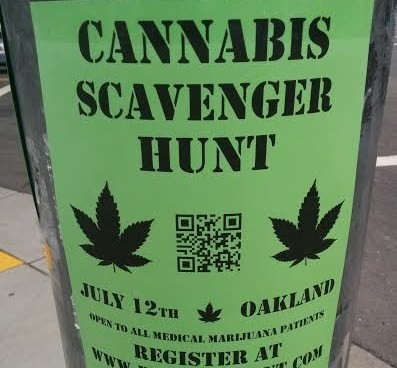Deciphering the Code

What the state law does regulate is fairly simple. Basically, IF the local government gives its blessing for a commercial activity, or if it simply refuses to address it, the state will happily provide a license to allow said activity. They’ll very happily take your taxes and won’t arrest, fine or prosecute unless you break their rules.
So far, the rules encompass several hundred pages of regulations, legislation and restrictions–but that’s because they aren’t done writing them all yet 🙂
Meanwhile, the rest of us are wondering: 1) where can I get it, and 2) where can I grow it? So I decided to undertake the insane scavenger hunt of reading through all of these local regulations and condensed them for easy reading.
Thus far, I’ve completed the 58 counties, along with a few larger cities, while some stay on hold till regulations pass. And after a much-needed sabbatical in a padded cell, I can say finding these ordinances is a lot like herding cats–but it can be done.
How to Heard Cats

Finding the laws should be fairly straightforward. We just go to the city or county website, hit the search button and type in “marijuana” or “cannabis.” The results should take us to a page addressing FAQ’s with links to the pertinent ordinances.
In a perfect world, that’s how it is. Some cities like Santa Cruz, bless them, even make flow charts to navigate their rules.
Unfortunately, the rest of us find ourselves firmly planted in the not-so-perfect real world; we’ll have to dig through a bunch of ordinances Municode or Amlegal.
When searching for local cannabis regulations, we often get a hundreds-of-pages-long deluge addressing the commercial code and regulations. And, more often than not, you can read through the entire code without finding a single reference to personal medical cultivation or non-commercial rules.
Though that doesn’t mean local rules don’t exist. Sometimes they’re just very hard to find, so it’s a risky move to fall back on state laws by default. If we run into a brick wall, there’s only one option left–pick up the phone.
Sometimes We Even Get Answers

The part of the scavenger hunt directed me to Irvine, which has a very clear Prop 64 information page. The city only allows commercial testing labs yet completely bans dispensaries, forcing residents to go next door to Santa Ana (or elsewhere) for purchases.
But what if you want to grow your own? The city of Irvine simply refers to state law on their website:
How much and where can a person grow cannabis?
Under Health and Safety Code section 11362.2 (a) (1), personal cultivation is subject to the following limitations: (1) A person shall plant, cultivate, harvest, dry, or process plants in accordance with local ordinances, if any; (2) The living plants and any cannabis produced by the plants in excess of 28.5 grams are kept within the person’s private residence, or upon the grounds of that private residence (e.g., in an outdoor garden area), are in a locked space, and are not visible by normal unaided vision from a public place; (3) Not more than six living plants may be planted, cultivated, harvested, dried, or processed within a single private residence, or upon the grounds of that private residence, at one time.
It’s a very clear, succinct, and greatly appreciated, answer. But it doesn’t tell those who need to grow more than six plants for medical reasons how to comply.
Furthermore, Irvine’s code of ordinances isn’t 100% clear on the subject since it previously restricted medical cultivation to indoor only. According the their FAQs, IPD’s Lieutenant Mark Anderson is the man with the answers.
Thankfully, he is. So far, Lieutenant Anderson was the first and only person to actually call back with a response to the latest round of data collection. He informed us that the city’s referring back to state legislation for medical grows as well, namely 11362.77 and 11362.775. And, yes, a patient can grow outdoors if it’s for their medical use.
In other words, the city may ban dispensaries and other commercial uses, but doesn’t prevent our right to grow medical cannabis. As Lieutenant Anderson explains, it’s clear if you actually take a look at it.
On second look, it does appear that the state regulations allow a municipality only to exceed the base limits established by Prop 64 for medical use. The law does not allow cities to reduce a patient’s cannabis amount when their doctor says he or she needs more.
So are the counties that limit personal medical cultivation to six plants per property, no matter what, in violation of state law? Probably. It’s a question that can only be answered through a legal battle, and those can get very expensive.
Meanwhile, the rest of those who don’t feel up to that challenge should know what limits their municipalities are trying to enforce, whether those rules are legal or not.
Usually We Get a One-Way Ticket to Phone Tree Hell
Perris is still developing their ordinances, so it’s hard to know for sure where to find their most recent personal cultivation rules. In cases like this, it’s easiest just to ask code enforcement.
Their representative was helpful attempting to sift through the 36 returns on Muni-code to find their recreational and personal medical cultivation rules.
Unfortunately, the rep hit the same brick wall we did. Apparently no one had even asked the question before. Eventually, he gave an admirably sincere, frank answer: at the moment, the city’s only regulating commercial activity.
If Perris suspects a medical grow masquerading as an unlicensed personal one, it’ll simply hand it off to the Riverside County Sheriff. Now we can just call the Riverside County Sheriff for some answers, right?
Not exactly. It turns out trying to use the listed numbers to call the Riverside County Sheriff is an exercise in pure futility.
A call to the non-emergency number (given by our friendly code enforcement officer) resulted in an uninformative recorded message instructing us to call a different number.
A phone call to the Riverside Sheriff’s Office Perris Station will get you a phone tree directing you to yet more numbers. I actually broke down in a fit of hysterical laughter when I called to speak to a deputy and heard, “the toll free number that you are calling from is not available in your area.”
Apparently, you need a secret decoder ring to talk to a Riverside County Sheriff.
But L.A. Takes the Cake
There isn’t much guidance on Los Angeles City’s website regarding non-commercial cultivation. But there is an entire department dedicated to answering irritating questions like ours. Eureka! This will result in victory for sure!

Sorry, couldn’t get through that one with a straight face.
When asked where the personal medical cultivation ordinance was, office staff answered they weren’t 100% sure; but they would try to respond as quickly as possible if I emailed the question. They also warned it may take a while to get a response.
Evidently, the department only has two full-time employees and is relying on manpower loans from other departments to process the hundreds of Measure M applications. I promptly sent the email on January 25. No answer yet.
Why Does It Matter? I’ve Got a Medical Card

Here’s the problem. If the City of Los Angeles decides that the medical grow for you and your qualified patients should be classified as commercial, you could be subject to a maximum civil penalty of $20,000 for every offense.
Each day a violation continues is deemed a new and separate offense. You can also be subject to a criminal misdemeanor, punishable by a fine of up to $1,000 or up to six months in jail.
It’d be really, really good to know exactly what the local laws are.
For the record, The Los Angeles City website has half the answer on their cannabis regulations homepage:
“It is unlawful for a person to establish, operate or participate in a medical marijuana collective or cooperative unless in a dwelling unit with three or fewer qualified patients, persons with identification cards or primary caregivers, or any combination thereof.”
Of course, this doesn’t say what the allowable square footage for such a grow is, what the regulations are for growing indoors, nor gives a link to where we can look up these regulations ourselves.
They do, however, have a very prominent link to report any “unlawful activity.”
What We’re Finding When We Do Get Answers
As stated, there are literally hundreds of cannabis rule variations at the local level. In many cases, cities still have months before they can finish drafting a working ordinance. Many more wait for elections to impose taxes as well. There are even more variations on where these regulations and codes can be found and how the city posts new laws once finalized.
To be fair, this is absolutely no fault of the cities. The truth is, the state didn’t even have its own regulations ready until late last year. As a result, any municipalities that developed their ordinances early were risking “jumping the gun.” Worse, they risked tying their own hands legally if unexpected problems arose.
And, as suspected, there were huge changes between the original proposed state regulations and the final versions. One of the largest? The elimination of Prop 64’s mandatory five-year ban on very large cultivation licenses. This has thrown several counties into near chaos and sparked a lawsuit by the California Growers Association.
To make matters more complex, some municipalities are considering rules that may not work if one, or some, of the current lawsuits succeed. Some communities are considering charging for personal cultivation “permits.” Fillmore in Ventura County charges $176 to grow six personal plants indoors.
The VC Star actually reported this fee as a reasonable compromise since Fillmore was originally planning to charge over $700. But the city may find itself holding the bag for those permit fees if the ACLU and DPA win their lawsuit against Fontana for doing roughly the same thing.
All this mess, combined with resistance from anti-legalization groups, is causing some districts to just throw up their hands and ban everything state law allows.
Colusa County bans all commercial activity, dispensaries and deliveries, and restricts all cultivation to six indoor plants. This limit applies to medical and adult use, no matter how many patients live on the property. Also, cultivation is required to be in a permitted and approved accessory structure on the same property, not an inhabited dwelling.
At least we know where the city stands. It only took five minutes to lay out a summary of their rules. In short, you want weed? Go somewhere else. Medical patient? Get there faster.
Of course, it’s possible that Colusa just doesn’t want to become the latest target of the pharmaceutical funded anti-marijuana groups popping up everywhere a citizen dares to take a toke. Why are pharmaceutical companies funding anti-legalization legislation?
One hesitates to make guesses or accusations. Still, it’s hard not to notice when a big pharma company gives half-a-million dollars to the anti-cannabis group, Arizonans for Responsible Drug Policy, then gets preliminary approval for a synthetic marijuana.
It’s Going to Work Out–Eventually

We’ve said it before and we’ll say it again: if you feel lost, you’re not alone. Eventually these rules will be sorted out and everyone will know where they stand. Perhaps a brilliant mind will develop a GPS-based app that gives you the local laws (or a secret decoder ring?). Then you’ll know if your laws are different from the county dwellers across the street.
In the meantime, play it safe and never assume you know the local rules if there’s any lack of clarity. Remember, it’s a bad idea to simply rely on state laws if you can’t find a local ordinance addressing your question(s). Laws are changing quickly and an ordinance may have reached approval in the past few weeks; they may not be listed with the rest of the city’s codes until they’re updated.
We’ll do our best to update these rules as fast as possible, though if in doubt, pick up the phone. An ounce of prevention is worth a pound of cure–especially if you’re preventing criminal charges or $20,000 per day fines.
“Writing laws is easy, but governing is difficult.” —Leo Tolstoy, War and Peace
Deb Tharp is a cannabis activist, consultant, and writer. She began her cannabis activism at the age of 18, helping local candidates campaign door-to-door in the Midwest. Little did she know that the plant would save her husband's life a decade later. After watching him recover 60 pounds to his skeletal frame in a matter of months, she was convinced that the war on weed must end.
She ran for State Assembly in 2010 while completing her bachelor's degree at University of California, Irvine. During her campaign, she managed to bring cannabis legalization to the forefront of the debate. Little more than a year later, she was publicly arrested while gathering signatures for a cannabis ballot initiative in Orange County. She fired back at the county by qualifying Measure CC in Santa Ana under Kandice Hawes' of OC Norml’s expert leadership.
In the following years, she authored, qualified and helped to qualify over a dozen local legalization ballot initiatives across the state while teaching other activists how to do the same.
She currently writes for Nugg, the nation's largest online cannabis marketplace, while pursuing her law degree at Taft Law School and will graduate in 2021.








2 Comments
Bradley Southwood
Thanks for all the useful information. Any info on Fresno California?
Debbie Tharp
Hi Bradly, Thank you so much for dropping a note! Sorry it took a couple weeks to put together. We are starting to add info on city regulations here: http://50.112.24.3/california-cities-cannabis-regulations/ I don’t have Fresno up there yet, but they are going to allow medical cannabis. They don’t have their ordinances completely put together yet. http://fresnocannabis.org/2017/fresno-city-council-oks-medical-cannabis-licensing/ It’s definitely exciting news considering the area though! 🙂